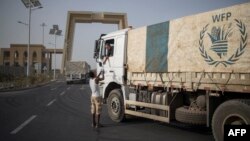The U.N. refugee agency, UNHCR, reports it is stepping up critical aid to thousands of refugees and internally displaced people in conflict-ridden northern Ethiopia.
Aid agencies report they now have unhindered access to Ethiopia’s northern Tigray, Afar and Amhara regions. They say the November 2 peace agreement signed between the Ethiopian government and the rebel Tigray People’s Liberation Front is holding.
Millions of people, especially in Tigray, have been largely deprived of food, medicine, and other essentials throughout the two-year conflict. Since the peace treaty was signed, UNHCR representative in Ethiopia, Mamadou Dian Balde said his agency and partners have been able to increase the level of assistance and protection within the region.
Speaking from the capital Addis Ababa, he said as of this week, the UNHCR has been able to send in 61 trucks loaded with much needed relief supplies into Tigray.
“This is a game changer,” Balde said. “It is an opportunity for us. Will it last or not? I do not have the capabilities to predict that. … Things remain always fragile. But all steps taken by both parties are very important.”
Balde said UNHCR has relocated 16,000 Eritrean refugees to the recently established Alemwach site in the Amhara region. It also has assisted more than 7,000 Eritreans who had been stranded in two other camps in western Tigray so they can rebuild their lives and stand on their own.
He said a week ago he met a recently relocated refugee, who told him how relieved he was that his children could finally go back to school after more than two years.
“The fact that they were resuming education, that was indeed heartbreaking to hear,” Balde said. “That during all this time, they could not have it and they were relieved we are able to help refugees, children resume education and start normal life.”
Balde said the UNHCR also is working closely with local authorities in northern Ethiopia to support Ethiopians displaced by the conflict.
Between January and October, he said the agency has provided various protection services, shelter, household items and other services to more than 2 million internally displaced people.









